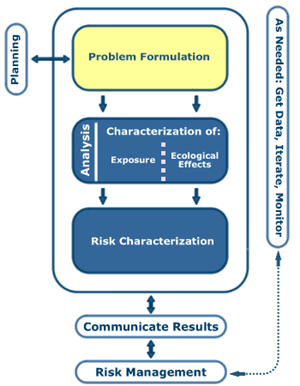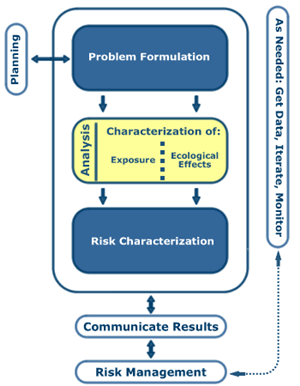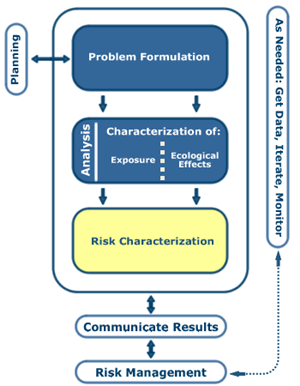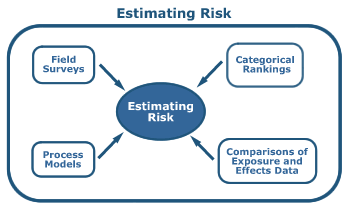Conducting an Ecological Risk Assessment
Even an ecological risk assessment starts with a good plan. Before anything though there is a need to make judgments early when planning major risk assessments regarding the purpose, scope, and technical approaches that will be used. To start, risk assessors will typically ask the following questions:
- Who/What/Where is at risk?
- Individual
- General population
- Lifestages such as juveniles or adults
- Population subgroups — highly susceptible (for example, due to genetics) and/or highly exposed (for example, based on geographic area)
- Different species — mink, for example, are highly susceptible to PCBs
- What is the environmental hazard of concern?
- Chemicals (single or multiple/cumulative risk)
- Radiation
- Physical (changes to a habitat)
- Microbiological or biological (disease or invasive species)
- Nutritional (for example, fitness or metabolic state)
- Where do these environmental hazards come from?
- Point sources (for example, smoke or water discharge from a factory; contamination from a Superfund site)
- Non-point sources (for example, automobile exhaust; agricultural runoff)
- Natural sources
- How does exposure occur?
- Pathways (recognizing that one or more may be involved)
- Air
- Surface Water
- Groundwater
- Soil
- Solid Waste
- Food
- Routes (and related human activities that lead to exposure)
- Ingestion (both food and water)
- Contact with skin
- Inhalation
- Non-dietary ingestion (for example, preening/grooming behavior)
- Pathways (recognizing that one or more may be involved)
- What does the body do with the environmental hazard and how is this impacted by factors such as life-stage, genetics, species differences, etc.?
- Absorption - does the body take up the environmental hazard
- Distribution - does the environmental hazard travel throughout the body or does it stay in one place?
- Metabolism - does the body break down the environmental hazard?
- Excretion - how does the body get rid of it?
- What are the ecological effects?
- Example of some ecological effects include, but are not limited to, changes in reproductive rates, tumors, effects on the nervous system, and mortality.
- Example of some ecological effects include, but are not limited to, changes in reproductive rates, tumors, effects on the nervous system, and mortality.
- How long does it take for an environmental hazard to cause a toxic effect? Does it matter when in a lifetime exposure occurs?
- How long?
- Acute - right away or within a few hours to a day
- Subchronic - weeks or months (for humans generally less than 10% of their lifespan)
- Chronic - a significant part of a lifetime or a lifetime (for humans at least seven years)
- Intermittent
- Timing
- Is there a critical time during a lifetime when a chemical is most toxic (e.g., fetal or embryonic development, juvenile stages, adulthood)?
- How long?
Phase 1:
 Phase 1: Problem Formulation
Phase 1: Problem FormulationThe objective of the problem formulation phase is to define an assessment endpoint to determine what ecological entity is important to protect. An ecological entity can be:
- A species (for instance: piping plover)
- A functional group of species (for instance: piscivores - i.e., fish eaters)
- A community (for instance: benthic invertebrates)
- An ecosystem (for instance: lake)
- A specific valued habitat (for instance: wet meadows)
- Another entity of concern
Once the entity has been identified, the next step is to determine what specific attribute(s) of the entity is potentially at risk and important to protect. This provides a basis for measurement in the risk assessment.
Determining ecological relevance in specific cases requires professional judgment based on site-specific information, preliminary surveys, or other available information.
Ecological relevance is linked to:
- Nature and intensity of effects
- Spatial and temporal scales of effects
- Potential for recovery
- Level of organization potentially affected
- The entity's role in the ecosystem
More than one level of organization may need to be considered.
It is rarely clear which of these ecosystem components are most critical to ecosystem function. Further, professionals and the public don't always agree on which are most valuable. This increases the challenge in choosing which ecological characteristics to protect. Three principal criteria clarify this choice:
- Ecological relevance
- Susceptibility to known or potential stressors
- Relevance to management goals
The challenge is to find ecological values that are scientifically rigorous and are also recognized as valuable by risk managers and the public. Possible successful examples include:
- Endangered species or ecosystems
- Commercially or recreationally important species
- Ecosystem functions or services such as food supply, flood control, or nutrient cycling
- Aesthetic values such as clean air in national parks
- Existence of charismatic species such as eagles or whales
Once assessment endpoints are chosen, a conceptual model is developed to provide a visual representation (a map, flow chart, or schematic) of hypothesized relationships between ecological entities and the stressors to which they may be exposed, accompanied by a written description of this process and of the risk questions. These models include information about:
- Source
- Stressors
- Receptors
- Potential exposure
- Predicted effects on an ecological entity (the assessment endpoint)
Phase 2:
 Phase 2: Analysis
Phase 2: AnalysisThe objective of the analysis phase is to provide the ingredients necessary for determining or predicting ecological responses to stressors under exposure conditions of interest.
Analysis is the determination of what plants and animals are exposed and to what degree they are exposed and if that level of exposure is likely or not to cause harmful ecological effects. Calculations used may include:
- hazard quotients (e.g., the ratio of chemical contaminant concentration to a selected screening benchmark) to quantify risk; and
- various parameters to determine the levels of exposure to a stressor (e.g., chemical contaminant) by a selected plant or animal (receptor), such as:
- Area use: the proportion of the site that is in the area an animal typically uses during normal activities (home range); OR the proportion of an animal’s home range that is within a site;
- Food ingestion rate: how much food is consumed by an animal over a specific period of time (typically, one day);
- Bioaccumulation rates: the process by which chemicals are taken up by a plant or animal either directly from exposure to a contaminated medium (soil, sediment, water) or by eating food containing the chemical;
- Bioavailability: how easily a plant or animal can take up a particular contaminant from the environment;
- Life stage: juvenile, adult, etc.
- Area use: the proportion of the site that is in the area an animal typically uses during normal activities (home range); OR the proportion of an animal’s home range that is within a site;
Phase 3:
 Phase 3: Risk Characterization
Phase 3: Risk CharacterizationThe objective of the risk characterization phase is to use the results of analysis to estimate the risk posed to ecological entities. The assessor then describes the risk, indicating the overall degree of confidence in the risk estimates, summarizing uncertainties, citing evidence supporting the risk estimates, and interpreting the adversity of ecological effects.
When estimating ecological risk, factors considered include:
- Is the risk acute or chronic?
- What is the severity of effects?
- What is the time over which they occur?
- Is the risk to one species or many species?
- How many organisms are at risk?
Some approaches used to answer these questions and develop the risk estimate include:
- Field observational studies (surveys)
- Categorical rankings
- Process models that rely partially or entirely on theoretical approximations of exposure and effects
- Comparisons of exposure and effects data

Principles of Conducting Risk Characterizations
A good risk characterization will restate the scope of the assessment, express results clearly, articulate major assumptions and uncertainties, identify reasonable alternative interpretations, and separate scientific conclusions from policy judgments. EPA's risk characterization policy calls for conducting risk characterizations in a manner that is consistent with the following principles:
- Transparency - The characterization should fully and explicitly disclose the risk assessment methods, default assumptions, logic, rationale, extrapolations, uncertainties, and overall strength of each step in the assessment.
- Clarity - The products from the risk assessment should be readily understood by readers inside and outside of the risk assessment process. Documents should be concise, free of jargon, and should use understandable tables, graphs, and equations as needed.
- Consistency - The risk assessment should be conducted and presented in a manner which is consistent with EPA policy, and consistent with other risk characterizations of similar scope prepared across programs within the EPA.
- Reasonableness - The risk assessment should be based on sound judgment, with methods and assumptions consistent with the current state-of-the-science and conveyed in a manner that is complete, balanced, and informative.
In order to achieve this in a risk characterization, these same principles need to have been applied in all of the previous steps in the ecological risk assessment which lead up to the risk characterization.
- Learn more about risk characterization from the Risk Characterization Handbook.
